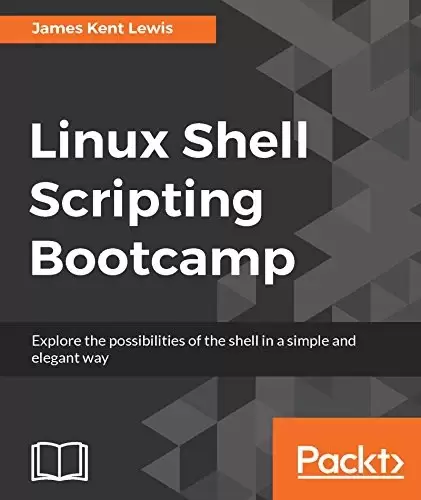
Book Description
Key Features
- Understand expressions and variables and how to use them practically
- Familiarize yourself with the various text filtering tools available in Linux
- A fast-paced and concise guide that gets you well versed with linux shell scripting.
Book Description
Linux Shell Scripting Bootcamp is all about learning the essentials of script creation, validating parameters, and checking for the existence of files and other items needed by the script.
We will use scripts to explore iterative operations using loops and learn different types of loop statements, with their differences. Along with this, we will also create a numbered backup script for backup files.
Further, you will get well-versed with how variables work on a Linux system and how they relate to scripts. You’ll also learn how to create and call subroutines in a script and create interactive scripts. The most important archive commands, zip and tar, are also discussed for performing backups. Later, you will dive deeper by understanding the use of wget and curl scripts and the use of checksum and file encryption in further chapters.
Finally, you will learn how to debug scripts and scripting best practices that will enable you to write a great code every time! By the end of the book, you will be able to write shell scripts that can dig data from the web and process it efficiently.
What you will learn
- Get acquainted with the basics of a shell script to serve as a refresher for more advanced topics
- Learn different ways to create and run a script
- Discuss the passing and verification of parameters, along with the verification of other items.
- Understand the different forms of conditions and loops, and go over the sleep command in detail
- Learn about different ways to handle the reporting of return codes
- Create an interactive script by reading the keyboard and use subroutines and interrupts
- Create scripts to perform backups and go over the use of encryption tools and checksums
- Use wget and curl in scripts to get data directly from the Internet
About the Author
James Kent Lewis has been in the computer industry for over 35 years. He started out writing BASIC programs in high school and used punch cards in college for his Pascal, Fortran, COBOL, and assembly language classes. He himself learned the C programming language by writing various utilities, including a fully-functional text editor, which he uses everyday. He started out using DOS and AIX, and then OS/2. Linux is now his operating system of choice. Jim has worked in the past for several companies, including IBM, Texas Instruments, Tandem, Raytheon, Hewlett-Packard, and others. Most of these positions dealt with low-level device drivers and operating system internals. In his spare time he likes to create video games in Java.He has written articles for IBM Developer Works and has one patent.
Table of Contents
Chapter 1. Getting started with shell scripting
Chapter 2. Working with variables
Chapter 3. Using loops and the sleep command
Chapter 4. Creating and calling subroutines
Chapter 5. Creating Interactive Scripts
Chapter 6. Automating Tasks with Scripts
Chapter 7. Working with Files
Chapter 8. Working with wget and curl
Chapter 9. Debugging scripts
Chapter 10. Scripting Best Practices
中文:
书名:Linux Shell Scripting Bootcamp
Key Features
- 了解表达式和变量以及如何实际使用它们
- 熟悉Linux中提供的各种文本过滤工具
- 这是一本快速而简洁的指南,让您能够很好地掌握Linux外壳脚本编写。
图书描述
Linux Shell脚本训练营的主要内容是学习脚本创建的要点、验证参数以及检查脚本所需的文件和其他项是否存在。
我们将使用脚本探索使用循环的迭代操作,并学习不同类型的循环语句及其差异。除此之外,我们还将为备份文件创建一个带编号的备份脚本。
此外,您还将非常熟悉变量在Linux系统上的工作方式以及它们与脚本的关系。您还将学习如何在脚本中创建和调用子例程,以及如何创建交互脚本。还讨论了用于执行备份的最重要的存档命令ZIP和TAR。稍后,您将在后续章节中通过了解wget和cURL脚本的使用以及校验和和文件加密的使用来更深入地研究。
最后,您将学习如何调试脚本和脚本编写最佳实践,这将使您每次都能编写出色的代码!到本书结束时,您将能够编写能够从Web中挖掘数据并高效处理数据的外壳脚本。
你将学到什么
- 熟悉外壳脚本的基础知识,作为更高级主题的复习
- 了解创建和运行脚本的不同方式
- 讨论参数的传递和验证,以及其他项目的验证。
- 了解不同形式的条件和循环,并详细查看睡眠命令
- 了解处理返回代码报告的不同方法
- Create an interactive script by reading the keyboard and use subroutines and interrupts
- 创建脚本以执行备份并检查加密工具和校验和的使用
- 在脚本中使用wget和cURL直接从Internet获取数据
关于作者
詹姆斯·肯特·刘易斯。 已经在计算机行业工作了35年以上。他从高中开始编写基本程序,在大学里用穿孔卡片上帕斯卡、Fortran、COBOL和汇编语言课程。他自己通过编写各种实用程序来学习C编程语言,包括他每天使用的功能齐全的文本编辑器。他开始使用DOS和AIX,然后使用OS/2。Linux现在是他选择的操作系统。Jim过去曾在几家公司工作过,包括IBM、德州仪器、Tandem、雷神、惠普和其他公司。这些职位大多涉及低级设备驱动程序和操作系统内部。在业余时间,他喜欢用Java制作视频游戏。他曾为IBM Developer Works撰写文章,并拥有一项专利。
目录表
第1章.开始使用外壳脚本编写
第2章:使用变量
第3章.使用循环和睡眠命令
第4章.创建和调用子例程
第5章.创建交互脚本
Chapter 6. Automating Tasks with Scripts
第7章.使用文件
第8章.使用wget和curl
Chapter 9. Debugging scripts
第10章.编写脚本最佳实践
评论前必须登录!
注册